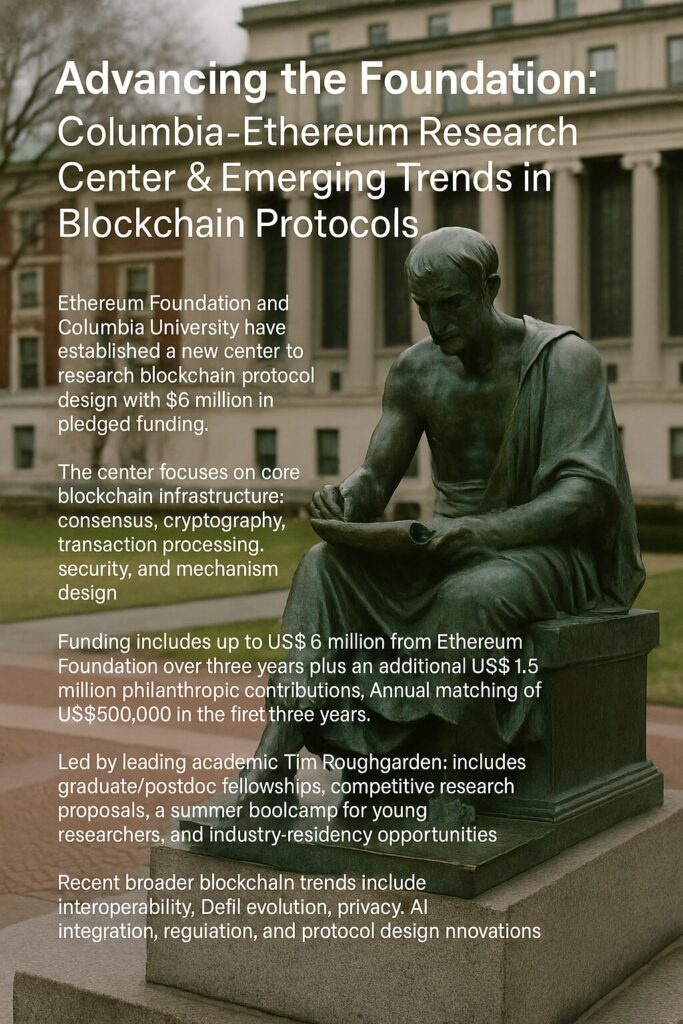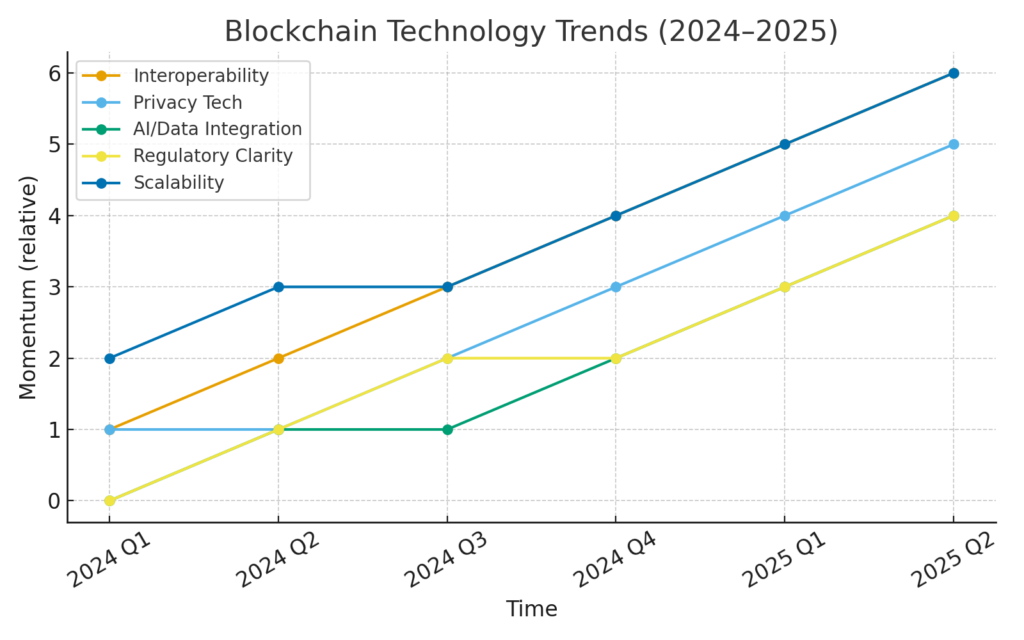
Main Points :
- Ethereum Foundation and Columbia University have established a new center to research blockchain protocol design with $6 million in pledged funding.
- The center focuses on core blockchain infrastructure: consensus, cryptography, transaction processing, security, and mechanism design.
- Funding includes up to US$6 million from Ethereum Foundation over three years plus an additional US$1.5 million philanthropic contributions. Annual matching of US$500,000 in the first three years.
- Led by leading academic Tim Roughgarden; includes graduate/postdoc fellowships, competitive research proposals, a summer bootcamp for young researchers, and industry-residency opportunities.
- Recent broader blockchain trends include interoperability, DeFi evolution, privacy, AI integration, regulation, and protocol design innovations.
1. Establishment of the Columbia-Ethereum Research Center
The Ethereum Foundation has partnered with Columbia Engineering to launch a dedicated research hub named the Columbia-Ethereum Research Center for Blockchain Protocol Design. The goal is to deepen understanding and foster practical innovation in the infrastructure layer of blockchain technology — the foundational protocols without which decentralized applications and systems cannot scale effectively or securely.
Over the first three years, Ethereum Foundation pledges US$6 million, including $500,000 per year investment, with matching and additional support from philanthropic sources amounting to US$1.5 million. The funds will be used for center operations, competitive academic research grants, postdoctoral fellowships, graduate student research, industry researcher residencies, events, and a bootcamp targeting young/junior researchers.
Professor Tim Roughgarden — a well-known figure in blockchain protocol design and computer science — will lead the centre. The leadership underscores the seriousness with which Ethereum is investing into academic research, recognizing that protocol design involves complex trade-offs among performance, security, decentralization, economics, and usability.
2. Research Focus Areas

The center intends to support multidisciplinary research spanning:
- Consensus mechanisms: how nodes in a decentralized system agree on transactions, blocks, and state despite faulty or adversarial behavior.
- Cryptography and security: ensuring confidentiality, integrity, and resistance to attacks, including possibly post-quantum threats.
- Transaction processing, incentive design, and mechanism design: balancing throughput, latency, fees; designing economic incentives so that participants behave in ways that preserve desired properties.
- Interplay with policy and economics: regulation, governance, compliance, and the broader economic impacts of blockchain infrastructure.
Also, educational components include a summer bootcamp aimed at young researchers to learn protocol design, and programs that facilitate collaboration between academia and industry. The aim is not only theoretical advances, but produce research that can translate into implementations and improvements in live blockchain networks.
3. Significance for Ethereum and Broader Ecosystem
This centre is part of Ethereum’s strategy to strengthen its infrastructure layer — a move to ensure that as scaling, security, and usability challenges grow, there is a solid base of academic insight and innovation. For Ethereum network builders, protocol developers, and startups, this creates opportunities:
- Access to cutting-edge research outputs that may lead to improvements in layer-1 or layer-2 protocols.
- Potential collaboration or hiring of graduates/postdocs trained in this environment.
- More rigorous evaluation of trade-offs (e.g. speed vs decentralization, layer-2 vs layer-1 scaling) built on deeper theoretical foundations.
For the broader blockchain ecosystem, this may accelerate new protocol designs, more secure consensus, and more efficient, usable systems, especially if insights move from academia into production.
4. Recent Trends That Align with the Center’s Mission

To contextualize, here are some of the current and emerging trends that make this kind of centre especially relevant:
- Interoperability & Cross-Chain Solutions: Projects and research emphasizing smooth communication between different blockchains (“bridges,” interoperability protocols) are increasingly critical. Interoperability reduces fragmentation and allows value and data flow across chains.
- Privacy-Enhancing Technologies: Zero-knowledge proofs, confidential transactions, and other cryptographic techniques that protect user data and transactional privacy are under active research and adoption. The risk of quantum computing is also pushing research into post-quantum cryptography.
- Integration with AI and Big Data: AI’s increasing role in blockchain applications — whether for predictive analytics, automated contract management, or oracle data — demands secure, efficient protocol layers. Also, how blockchain data is managed, indexed, and queried is a major concern.
- Regulatory Clarity and Governance: As more governments enact crypto/blockchain regulation, protocol design must account for compliance, privacy laws, and governance models that work under regulation.
- Scalability and Throughput: Every major blockchain project is trying to improve transaction speed, reduce gas/fee costs, support more complex applications. This includes development of better consensus protocols, sharding, economic mechanisms to share load, etc.
5. Opportunities for Revenue, Innovation, and Practical Use
For those seeking new crypto assets, new revenue streams, or using blockchain in practice, this situation offers multiple angles:
- Protocol Innovation as Value Driver: New protocols (e.g. better consensus, privacy layers, cross-chain interoperability) can become the basis for new tokens, service fees, or infrastructure products. Those who build or invest early in such layers may capture outsized value.
- Academic-Industry Partnerships: The center offers opportunities for industry partners (tools, node operators, layer-2 projects, or enterprises) to engage with research, pilot new ideas, fund research, or partner for prototyping — early access to breakthroughs.
- Talent Pipeline: Graduates, postdocs, and researchers trained here will have skills in protocol design, crypto economics, security — high demand areas. Hiring or collaborating may be both easier and more reliable in terms of quality.
- Application Layer Gains from Infrastructure Advances: If consensus / throughput / cost / privacy improve, that will reduce friction for DeFi, NFTs, supply chain, identity, gaming, IoT use cases. So assets/services dependent on these layers may see growth or cost reduction.
Recent Developments & Movement
Since the announcement, there are a few related developments worth noting:
- Ethereum Foundation has begun matching donations (up to US$500,000 annually) for the Columbia center to stimulate philanthropic support.
- There is increasing global momentum in deploying public blockchains into regulated finance: e.g. Swiss banks executing binding payments using public chains; stock exchanges using blockchain for issuance, trading, settlement.
- Upgrades in the Ethereum ecosystem (for example, improvements to gas, wallet usability, staking flexibility) continue to show that infrastructure, not just applications, is under pressure and evolving.
Conclusion
The launch of the Columbia-Ethereum Research Center for Blockchain Protocol Design marks a significant investment in what is often under-appreciated but vital: the foundational infrastructural layers of blockchain. For anyone interested in discovering new assets or business models in the crypto space, or applying blockchain in a practical manner, this signals both opportunity and direction. Research in consensus, scalability, privacy, cryptography, and incentive/ economic design will likely yield the next generation of protocols and networks that underpin value. Those who engage early — whether through research partnerships, infrastructure building, or investing in protocol innovations — stand to benefit as the broader ecosystem catches up. The trends of interoperability, privacy, regulation, and scalability make this center timely and potentially transformative.

